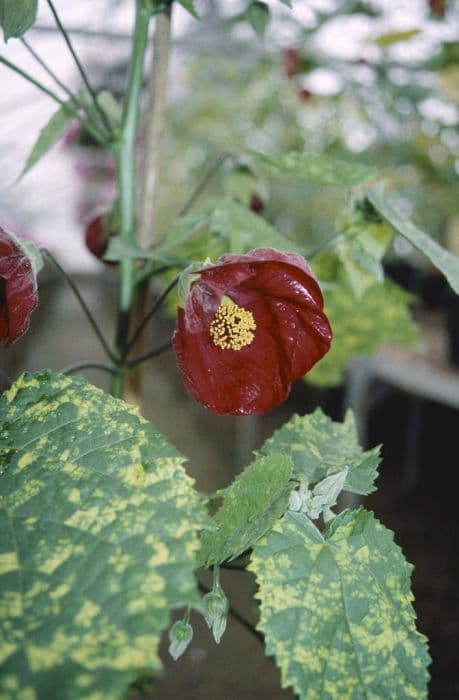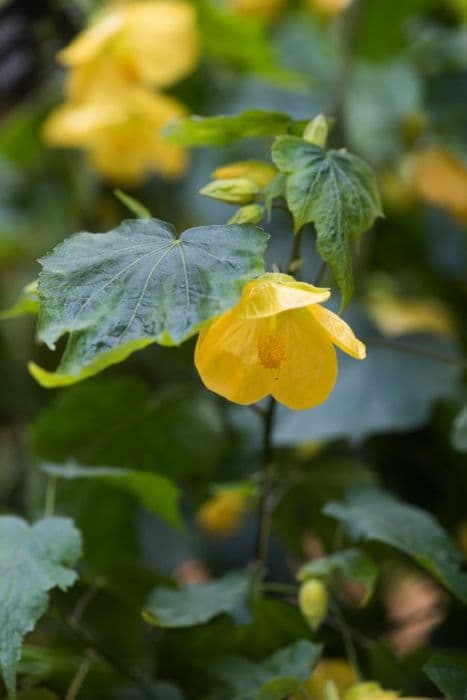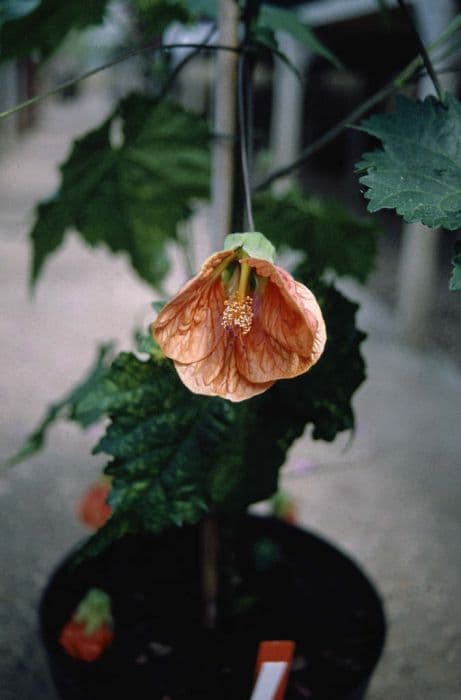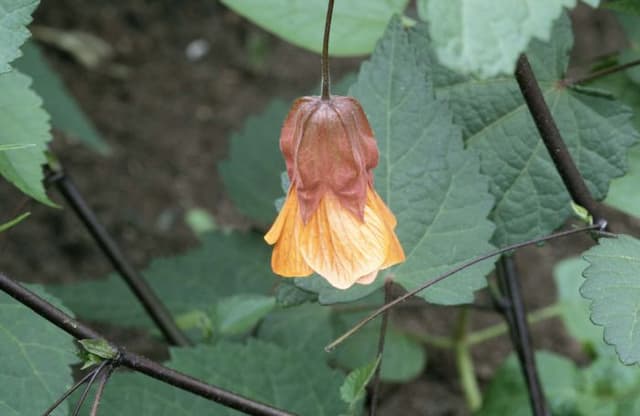African hemp Sparrmannia africana

ABOUT
The plant known as African hemp is a lush, evergreen shrub that boasts a dense and bushy appearance. Its leaves are large, heart-shaped, and boast a rich green color, with a glossy surface and a slightly hairy texture on the undersides. These leaves can create an impressive display, often contributing to the overall lushness of the plant. African hemp flowers are quite striking, typically white in color with a mass of prominent yellow stamens that create a showy contrast. These blooms can be big and showy, resembling pom-poms and appearing on the plant in clusters. Their distinct, fluffy look is due to the numerous stamens that extend outward, giving the flowers a somewhat shaggy appearance. After flowering, the plant forms capsules containing seeds, but these are less conspicuous than its showy blooms. The plant's overall appearance is one of robust vigor and tropical lushness, with the bold foliage and striking flowers combining to make it a popular choice for an ornamental plant in suitable climates.
About this plant
 Names
NamesSynonyms
African Hemp, African Linden, Room Linden, Cape Stock-Rose
Common names
Grewia populifolia, Sparrmannia cordifolia, Sparrmannia theophrastifolia, Sparrmannia tomentosa
 Toxicity
ToxicityTo humans
The African hemp is not widely known to be toxic to humans. However, as with many plants, individual allergies or sensitivities may occur, so it is always best to avoid ingestion and exercise caution when handling plants. If symptoms develop after ingestion or contact, seeking medical advice is recommended.
To pets
African hemp is not widely known to be toxic to pets either. However, pets may have different sensitivities to plants compared to humans, and ingestion can sometimes cause mild stomach upset. If a pet shows signs of distress after ingesting any part of the plant, it is advisable to contact a veterinarian.
 Characteristics
CharacteristicsLife cycle
Perennials
Foliage type
Evergreen
Color of leaves
Green
Flower color
White
Height
15 feet (4.6 meters)
Spread
8 feet (2.4 meters)
Plant type
Shrub
Hardiness zones
9
Native area
Africa
Benefits
 General Benefits
General Benefits- Ornamental Value: Sparrmannia africana, commonly known as African hemp, adds aesthetic value to gardens and homes with its large, heart-shaped leaves and fluffy white flowers.
- Ease of Care: African hemp is known for being relatively easy to care for, which makes it suitable for novice gardeners or those who prefer low-maintenance plants.
- Rapid Growth: The plant exhibits a fast growth rate, allowing gardeners to quickly establish visual impact and fill in garden spaces.
- Indoor Adaptability: It can be grown indoors in pots, which is beneficial for those with limited outdoor space or who live in climates not suitable for outdoor growth.
- Shade Tolerance: African hemp is tolerant of lower light conditions, making it versatile for planting in various light exposures in the garden or home.
- Seasonal Interest: With its year-round foliage and seasonal blooming, African hemp provides ongoing visual interest.
- Privacy Screen: Due to its large size, it can be used as a privacy screen or to create green boundaries in garden spaces.
- Textural Contrast: The texture of its leaves and flowers offers a contrast to other plants, which can enhance the overall design of a garden or indoor plant collection.
 Medical Properties
Medical PropertiesThis plant is not used for medical purposes.
 Air-purifying Qualities
Air-purifying QualitiesThis plant is not specifically known for air purifying qualities.
 Other Uses
Other Uses- Sparrmannia africana, commonly known as Cape Stock-rose, has been used as a filler plant in floral arrangements, due to its large, heart-shaped leaves and attractive flowers that can add bulk and a tropical feel.
- The fibrous bark of Cape Stock-rose has traditionally been utilized for making ropes and twines in some African cultures.
- The wood of Cape Stock-rose is light and can be used for crafting lightweight items such as picture frames or decorative objects.
- The plant is often used in educational settings, such as schools and botanical gardens, to teach students about pollination due to its large and accessible flowers.
- Insect-repellent properties of the Cape Stock-rose have been reported anecdotally, though not scientifically verified, for keeping certain pests away from nearby plants.
- The large leaves of the Cape Stock-rose can be used as natural wraps or coverings in outdoor settings or during traditional cooking methods in African cuisine.
- By planting Cape Stock-rose in urban environments, cities can add a visually-appealing element that offers shade and a small degree of noise reduction.
- The rapid growth of Cape Stock-rose makes it a suitable candidate for use in temporary garden displays or for quickly filling up landscape areas in need of greenery.
- Cape Stock-rose has potential as a dye plant, where its flowers can be used to extract pigments for natural dyeing processes.
- The plant may be used as a living classroom for ecological education, demonstrating the interactions between various insects and a native South African flowering plant.
Interesting Facts
 Feng Shui
Feng ShuiAfrican hemp is not used in Feng Shui practice.
 Zodiac Sign Compitability
Zodiac Sign CompitabilityAfrican hemp is not used in astrology practice.
 Plant Symbolism
Plant Symbolism- Growth: The rapid growth of the African hemp symbolizes personal or spiritual development and the idea of reaching towards one's goals much like the plant reaches towards the sunlight.
- Resilience: Since African hemp thrives in various conditions, it often symbolizes the ability to adapt and endure challenging situations, representing resilience and fortitude in life.
- Nourishment: As a lush, green plant, the African hemp symbolizes nourishment and sustenance, not just physically but also emotionally, nurturing growth and well-being.
- Protection: With its broad leaves, the African hemp may suggest shelter and protection, indicating a safe haven or a nurturing environment where one can thrive away from harm.
- Healing: Given that many plants are used in traditional medicine, African hemp might also symbolize healing and the restoration of health and balance.
 Water
WaterThe African Hemp requires consistent moisture, and it is best to water when the top inch of soil feels dry to the touch. Water thoroughly until moisture runs out of the drainage holes, which should be every week during the active growing season. In winter, reduce watering, but never let the soil dry out completely. Ensure you provide the plant with approximately 1 gallon of water during each watering session. Monitor the plant's response, as overwatering can lead to root rot, while under-watering can cause leaves to droop.
 Light
LightAfrican Hemp thrives in bright, indirect light but can tolerate some partial shade. It should be placed in a spot where it receives dappled sunlight or in a room with east or west-facing windows. Direct sunlight can scorch the leaves, so avoid placing it in a location that gets direct sun during the hottest part of the day.
 Temperature
TemperatureThe ideal temperature for African Hemp ranges between 60 and 75 degrees Fahrenheit. It can survive temporary drops to as low as 50 degrees Fahrenheit but should not be exposed to temperatures below that, as it can damage the plant. Avoid placing it near drafts, heating vents, or air conditioners to maintain a consistent temperature range.
 Pruning
PruningPruning African Hemp is essential to maintain its shape and encourage bushier growth. It should be pruned in the spring or early summer by cutting back leggy branches and removing any yellowed or dead leaves. You can prune the plant every year or as needed to remove any undesirable growth. Always use clean, sharp scissors or pruners to make clean cuts.
 Cleaning
CleaningAs needed
 Soil
SoilThe African hemp thrives best in a well-draining soil mix consisting of two parts peat or coco coir, one part perlite or pumice, and one part potting soil; it prefers a slightly acidic to neutral pH between 6.0 and 7.5.
 Repotting
RepottingAfrican hemp should be repotted every 2-3 years or when it outgrows its pot, usually in spring or early summer before the growth season.
 Humidity & Misting
Humidity & MistingThe African hemp requires high humidity levels, preferably between 60% and 80%, to thrive and maintain its lush foliage.
 Suitable locations
Suitable locationsIndoor
Provide bright, indirect light, and mist leaves.
Outdoor
Place in dappled sunlight, shelter from direct midday sun.
Hardiness zone
9-11 USDA
 Life cycle
Life cycleThe African hemp (Sparrmannia africana) begins its life cycle as a seed, which when provided the right conditions—moist soil, warmth, and light—will germinate and sprout into a seedling. The seedling stage is characterized by the growth of the first set of true leaves after the initial cotyledons (seed leaves). As the plant transitions into the vegetative stage, it develops a robust stem and a foliage of large, heart-shaped leaves, continuously growing larger and producing more leaves. Following the vegetative phase, it enters the reproductive stage, during which it produces clusters of small white to pale yellow flowers, usually in the late winter or spring. Once pollination occurs, usually by insects, the plant develops fruit capsules that contain the seeds. The plant's life cycle is completed when these seeds are dispersed, ready to germinate and grow into new African hemp plants.
 Propogation
PropogationPropogation time
Spring to Summer
The most popular method of propagating the African Hemp (Sparrmannia africana) is by taking stem cuttings. The best time to propagate this plant is in the late spring or early summer when the plant is actively growing. To do this, a healthy stem tip about 4 to 6 inches (about 10 to 15 cm) long is cut just below a leaf node. This cutting should have several sets of leaves. The lower leaves are then stripped off, and the cut end is dipped in rooting hormone powder to stimulate root growth. The stem is planted in a well-draining potting mix, ensuring at least one node is buried where roots can develop. The pot is then kept under warm, humid conditions until new growth indicates that the cutting has successfully taken root, which may take a few weeks. Careful watering is essential during this time to maintain moisture without causing rot.





![Abutilon [Yellow Trumpet]](/_next/image?url=https%3A%2F%2Fplants-admin.emdemapps.com%2Fimages%2Fplants%2F%2Fimages%2F604b5caa8b4fb.png&w=640&q=75)


